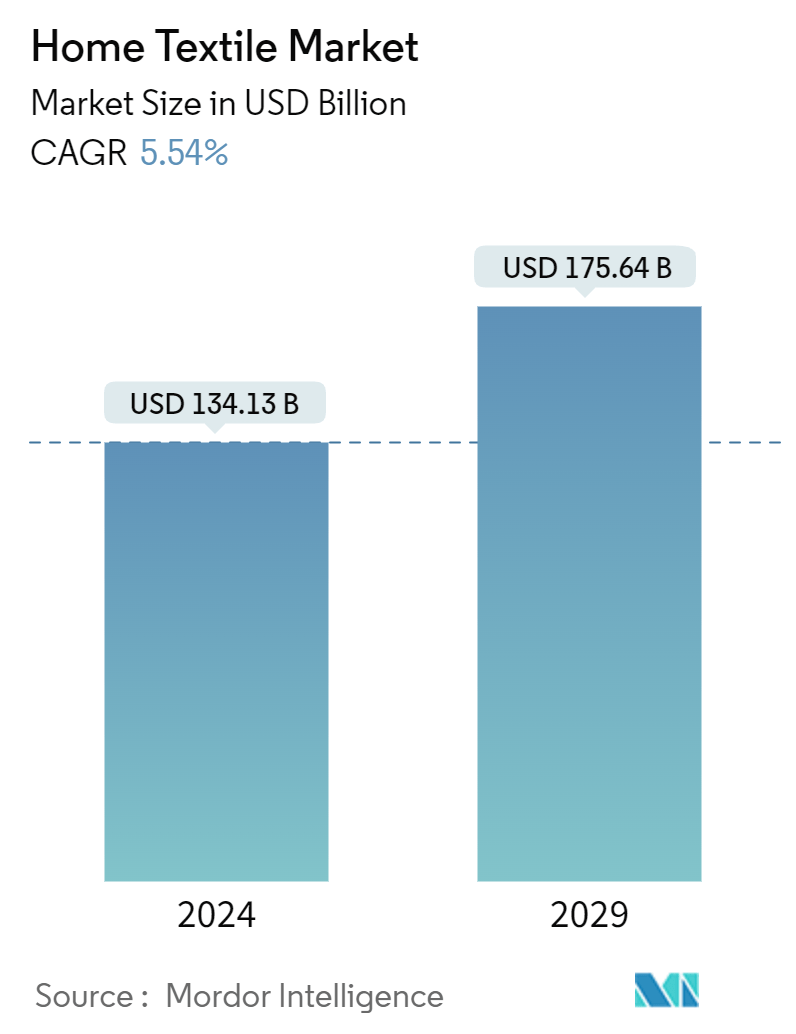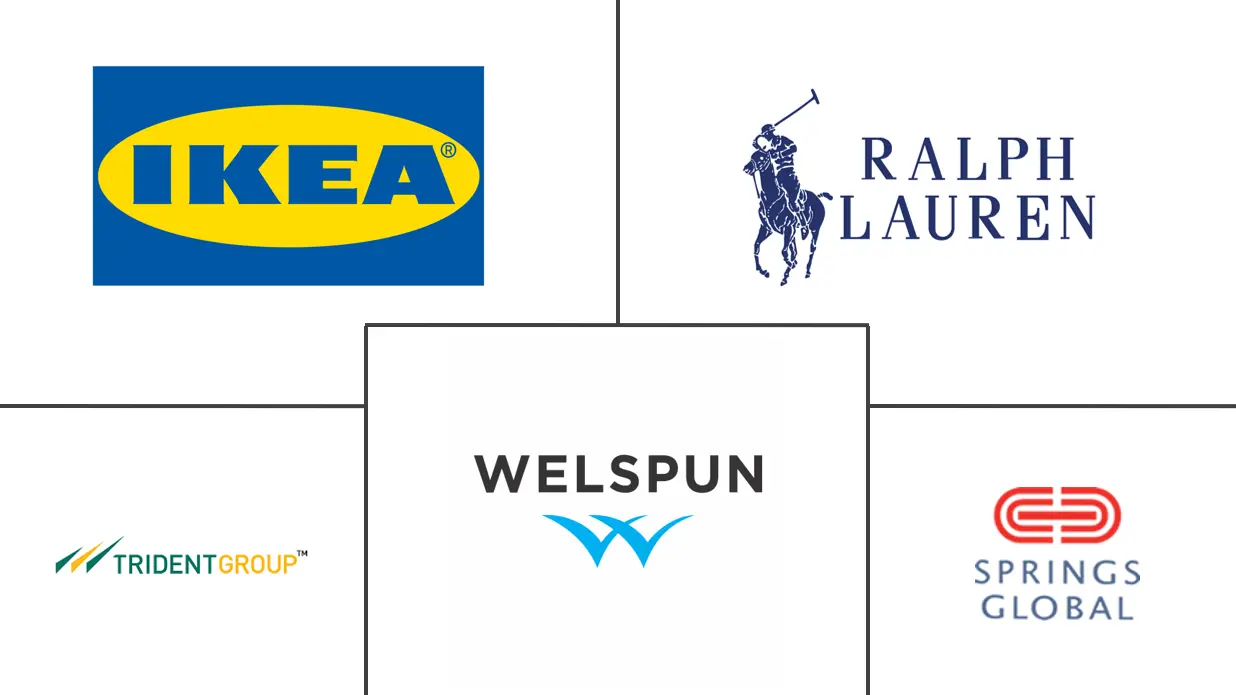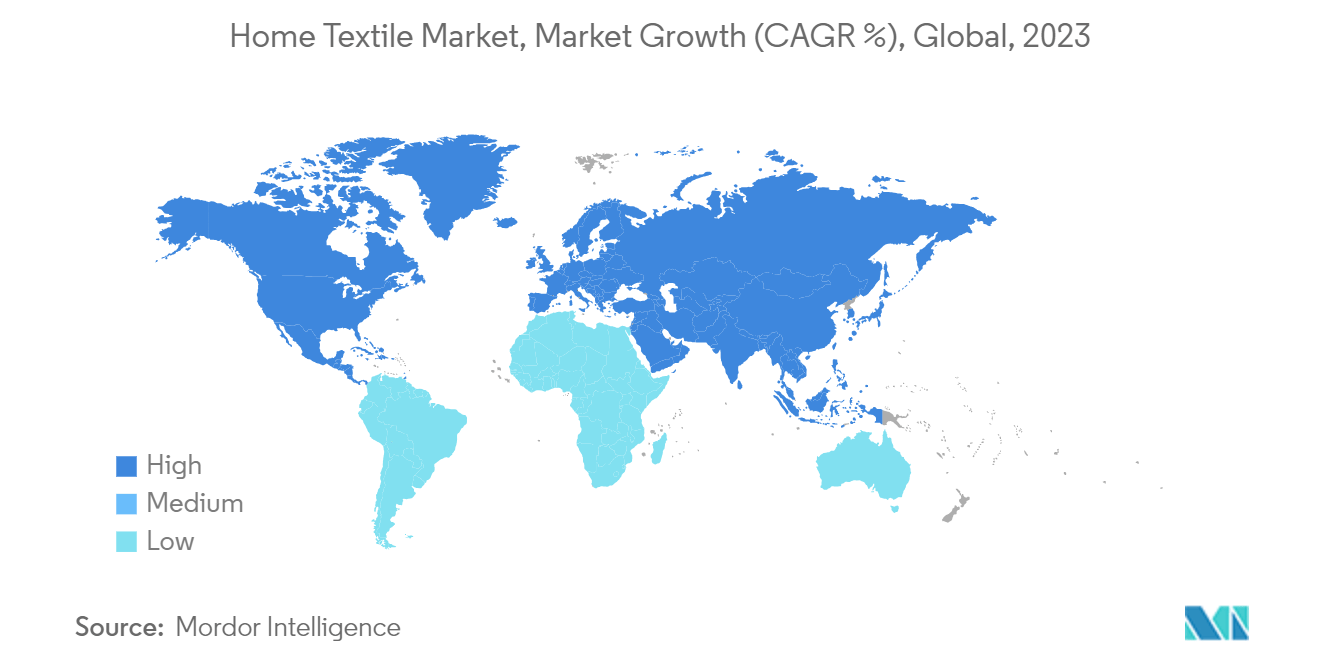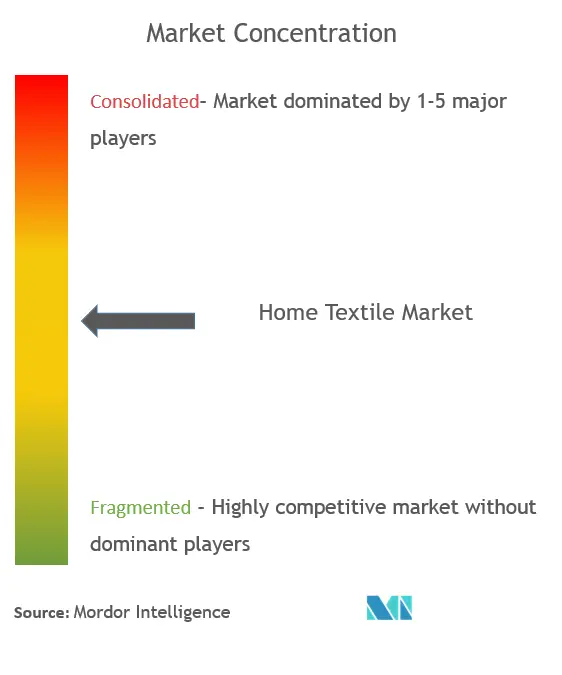Home Textile Market Size

| Study Period | 2020-2029 |
| Market Size (2024) | USD 134.13 Billion |
| Market Size (2029) | USD 175.64 Billion |
| CAGR (2024 - 2029) | 5.54 % |
| Fastest Growing Market | Europe |
| Largest Market | Asia Pacific |
Major Players
*Disclaimer: Major Players sorted in no particular order |
Home Textile Market Analysis
The Home Textile Market size is estimated at USD 134.13 billion in 2024, and is expected to reach USD 175.64 billion by 2029, growing at a CAGR of 5.54% during the forecast period (2024-2029).
Home textiles have transformed from being a basic necessity in modern households worldwide. They are now seen as a crucial representation of a homeowner's uniqueness, choices, and style. Manufacturers of these items have consistently worked towards introducing new designs, styles, high-quality materials, patterns, and uses to attract a broader range of consumers. As the real estate sector thrives and living standards improve, interior design and home decor spending has also risen. As a result, this trend is predicted to contribute significantly to market growth during the forecasted period.
The industry is witnessing steady growth driven by rising consumer spending on home renovation, growing residential real estate, and fashion sensitivity toward household furnishing. The United States and Europe are some of the biggest consumers, constituting more than 50% of the home textiles imports, with countries such as India, China, and Pakistan being the key suppliers. During the pandemic, all countries restricted their supply chain, which had a direct effect on the growth of the home textile market during the period. After the countries lifted their restrictions, the market returned to its pre-pandemic status.
Governments and favorable regulatory policies are anticipated to catalyze market disruption in the rising industry. This support has led to increased investments in the market, thereby bolstering its development. The global home textile market will likely encounter significant challenges due to the high costs associated with logistics. However, the expanding real estate market and the growing consumer expenditure on home renovation are projected to fuel market growth. The increase in popularity of smart homes and the rise in infrastructural development worldwide will lead to market growth during the forecast period. Furthermore, the evolving interior design trends in residential and commercial spaces are contributing to the positive momentum of the home textile market.
Home Textile Market Trends
Bed Linen and Bed Spread Segment is the Largest Growing Segment in the Market
The market is expected to experience growth due to the rising need for bed linen and bedspreads. Bed linen encompasses a variety of items such as blankets, mattresses, pillows, duvets, and bed covers. Also, bathrobes, towels, and bath mats fall under bath linen. The increasing demand for bed linen and bedspreads is driven by the growing fashion consciousness of urban consumers towards home furnishings and the expansion of end-use industries like hospitality and housing. This trend is expected to drive the market growth further.
The residential construction sector has experienced significant growth in recent years, increasing the real estate industry's value. This growth in housing has also resulted in a higher demand for home textiles, particularly bed linen products such as bedspreads, blankets, mattresses, mattress covers, pillows, duvets, duvet covers, and bed covers. Additionally, households spend more on home improvement activities like renovation and DIY projects, another critical factor driving the home textile market. The demand for home textiles has been positively influenced by the surge in housing starts, rapid urbanization, increased residential development, and rising disposable income. These factors have led to a strong interest in home renovation projects, resulting in a significant boost in the market for home textiles.

Asia Pacific Region is the Fastest Growing Region Home Textile Market
Competition in the regional market is fierce due to the presence of manufacturers with extensive geographical coverage, strong brand recognition, and wide distribution networks. Market participants are anticipated to prioritize product innovation by investing more in research and development. Strategies for gaining a competitive edge include developing products tailored to specific applications, engaging in price competition, and establishing efficient distribution channels. The number of mergers and acquisitions is projected to rise as companies seek to expand their reach geographically. This method of growth allows for the swift integration of new technologies, products, and customer bases into an organization.
The Asia-Pacific region is home to around 60% of the global population and is a significant hub for producing and exporting home textiles. Countries like India, China, and Pakistan are among the region's largest home textiles markets. Growth in the global home textiles market is driven by factors such as the housing boom in Asia-Pacific, evolving fashion trends in home textiles, and demand recovery from Western economies. The robust growth of the Asia-Pacific region can be attributed to factors like rising per capita spending, a large pool of potential consumers, increased investments by key regional players, and the improving lifestyles of consumers. These factors are also fueling the demand for home textiles. The growth of e-commerce has further boosted home textile sales worldwide as consumers increasingly turn to online platforms to purchase from the comfort of their homes.

Home Textile Industry Overview
The home textile market displays a moderate level of fragmentation, with the report examining key international players within this sector. While a select few major players hold significant market shares, consumer income remains a primary driver of demand. Larger companies compete through strategies such as bulk purchasing, extensive product offerings, and adept merchandising and marketing. Conversely, smaller enterprises concentrate on specific market segments, competing by offering a comprehensive range of products and superior customer service. Key market players are Welspun Group, Spring Global, Ralph Lauren, Trident Group, and IKEA System BV. The report offers market sizes and forecasts in value (USD) for all the above segments.
Home Textile Market Leaders
-
Welspun Group
-
Spring Global
-
Ralph Lauren
-
Trident Group
-
IKEA System B.V.
*Disclaimer: Major Players sorted in no particular order

Home Textile Market News
- December 2023:Ralph Lauren Corporation recently unveiled a significant and enduring partnership with Haworth Lifestyle Design, a renowned industry frontrunner in luxury furniture design, production, and distribution. This collaboration will empower Ralph Lauren to extend further and enhance its home business, solidifying its market position.
- March 2023: Welspun Group has successfully finalized the purchase of Sintex BAPL, a plastics products manufacturer that private equity firm KKR previously supported. A bankruptcy court approved this acquisition, and Welspun Corporation, a group subsidiary, carried it out. By acquiring Sintex BAPL, Welspun Group, known for its expertise in home textiles and line pipes, will be able to enhance its plastic business-to-consumer operations.
Home Textile Market Report - Table of Contents
1. INTRODUCTION
- 1.1 Study Assumptions and Market Definition
- 1.2 Scope of the Study
2. RESEARCH METHODOLOGY
3. EXECUTIVE SUMMARY
4. MARKET DYNAMICS AND INSIGHTS
- 4.1 Market Overview
-
4.2 Market Drivers
- 4.2.1 Increasing Residential Real Estate will Drive the Market
- 4.2.2 Growth of E-Commerce will Drive the Market
-
4.3 Market Restraints
- 4.3.1 Changing Consumer Preferences will Restrain the Growth of the Market
- 4.3.2 Increasing Raw Material Price will Restrain the Growth of the Market
-
4.4 Market Opportunities
- 4.4.1 Customized Products for the Customer Need
- 4.4.2 Online Platform for Selling the Products Acts as an Opportunity for the Market to Grow
- 4.5 Industry Value Chain Analysis
-
4.6 Industry Attractiveness - Porter's Five Forces Analysis
- 4.6.1 Bargaining Power of Suppliers
- 4.6.2 Bargaining Power of Buyers
- 4.6.3 Threat of New Entrants
- 4.6.4 Threat of Substitutes
- 4.6.5 Intensity of Competitive Rivalry
- 4.7 Insights on Technology Innovation in the Market
- 4.8 Impact of COVID-19 on the Market
5. MARKET SEGMENTATION
-
5.1 By Product
- 5.1.1 Bed Linen and Bed Spread
- 5.1.2 Bathroom Linen
- 5.1.3 Kitchen Linen
- 5.1.4 Upholstery and Curtains
- 5.1.5 Floor Coverings
-
5.2 By Distribution Channel
- 5.2.1 Supermarkets/Hypermarkets
- 5.2.2 Specialty Stores
- 5.2.3 Online
- 5.2.4 Other Distribution Channels
-
5.3 By Geography
- 5.3.1 North America
- 5.3.1.1 United States
- 5.3.1.2 Canada
- 5.3.1.3 Mexico
- 5.3.1.4 Rest of North America
- 5.3.2 Europe
- 5.3.2.1 United Kingdom
- 5.3.2.2 Sweden
- 5.3.2.3 France
- 5.3.2.4 Switzerland
- 5.3.2.5 Rest of Europe
- 5.3.3 Asia-Pacific
- 5.3.3.1 Hong Kong
- 5.3.3.2 Australia
- 5.3.3.3 Rest of Asia-Pacific
- 5.3.4 Middle East & Africa
- 5.3.4.1 United Arab Emirates
- 5.3.4.2 Saudi Arabia
- 5.3.4.3 Rest of Middle East and Africa
- 5.3.5 Latin America
- 5.3.5.1 Brazil
- 5.3.5.2 Rest of Latin America
6. COMPETITIVE LANDSCAPE
- 6.1 Market Concetration Overview
-
6.2 Company Profiles
- 6.2.1 Welspun Group
- 6.2.2 Spring Global
- 6.2.3 Ralph Lauren
- 6.2.4 Trident Group
- 6.2.5 New Sega Home Textiles
- 6.2.6 Shenzhen Fuana Household Products Co, Ltd.
- 6.2.7 Bed Bath & Beyond
- 6.2.8 IKEA System B.V.
- 6.2.9 Franco Textiles
- 6.2.10 H&M Home
- 6.2.11 Marvic Textiles*
- *List Not Exhaustive
7. MARKET OPPORTUNTIES AND FUTURE TRENDS
8. DISCLAIMER AND ABOUT US
** Subject To AvailablityHome Textile Industry Segmentation
Home textiles refer to fabrics and garments specifically intended for enhancing the décor of a residential environment. The report provides a comprehensive analysis of the home textile market, encompassing an evaluation of economic factors and sectoral contributions, an overview of the market landscape, an estimation of market size for critical segments, an identification of emerging trends within market segments, an exploration of market dynamics, and examination of logistics expenditures by end-user industries.
The market is segmented by product, by distribution channel, and by geography. The market is further segmented by product into bed linen and bedspread, bathroom linen, kitchen linen, upholstery, curtains, and floor coverings. The market is further segmented by distribution channel into supermarkets/hypermarkets, specialty stores, online, and other distribution channels. And by geography, North America, Latin America, Europe, Asia-Pacific, and Middle East & Africa. The report offers market sizing and forecasts for home textiles in value (USD) for all the above segments.
| By Product | Bed Linen and Bed Spread | |
| Bathroom Linen | ||
| Kitchen Linen | ||
| Upholstery and Curtains | ||
| Floor Coverings | ||
| By Distribution Channel | Supermarkets/Hypermarkets | |
| Specialty Stores | ||
| Online | ||
| Other Distribution Channels | ||
| By Geography | North America | United States |
| Canada | ||
| Mexico | ||
| Rest of North America | ||
| By Geography | Europe | United Kingdom |
| Sweden | ||
| France | ||
| Switzerland | ||
| Rest of Europe | ||
| By Geography | Asia-Pacific | Hong Kong |
| Australia | ||
| Rest of Asia-Pacific | ||
| By Geography | Middle East & Africa | United Arab Emirates |
| Saudi Arabia | ||
| Rest of Middle East and Africa | ||
| By Geography | Latin America | Brazil |
| Rest of Latin America |
Home Textile Market Research Faqs
How big is the Home Textile Market?
The Home Textile Market size is expected to reach USD 134.13 billion in 2024 and grow at a CAGR of 5.54% to reach USD 175.64 billion by 2029.
What is the current Home Textile Market size?
In 2024, the Home Textile Market size is expected to reach USD 134.13 billion.
Who are the key players in Home Textile Market?
Welspun Group, Spring Global, Ralph Lauren, Trident Group and IKEA System B.V. are the major companies operating in the Home Textile Market.
Which is the fastest growing region in Home Textile Market?
Europe is estimated to grow at the highest CAGR over the forecast period (2024-2029).
Which region has the biggest share in Home Textile Market?
In 2024, the Asia Pacific accounts for the largest market share in Home Textile Market.
What years does this Home Textile Market cover, and what was the market size in 2023?
In 2023, the Home Textile Market size was estimated at USD 126.70 billion. The report covers the Home Textile Market historical market size for years: 2020, 2021, 2022 and 2023. The report also forecasts the Home Textile Market size for years: 2024, 2025, 2026, 2027, 2028 and 2029.
Home Textile Industry Report
Statistics for the 2024 Home Textile market share, size and revenue growth rate, created by Mordor Intelligence™ Industry Reports. Home Textile analysis includes a market forecast outlook for 2024 to 2029 and historical overview. Get a sample of this industry analysis as a free report PDF download.



